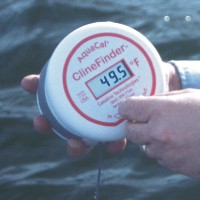| ClineFinder | ||||
One problem solved, right? Sort of. But how on earth do they know The ClineFinder, from Catalina Technologies, drops a sensor down into the water on a cable on a weight and digitally displays the water’s temperature at the sensor's depth. The cable is marked every two feet so the angler can calculate the depth. Large lakes in summer have a thermocline, an area where the water's temperature is in transition. In autumn, the surface cools.
That’s called turnover, and once that happens in fall, the lake becomes the same temperature from top to bottom, until a thermocline develops again, when weather warms. Once turnover makes the lake all the same temperature, fish scatter, swimming all different depths. That can make fishing tougher, and summer’s thermocline can be an advantage for anglers. The reason fish prefer the thermocline, where the temperature is transitioning, is another subject, but water oxygenation is highest there, a basic reason. Smaller, shallower lakes form less of a thermocline or none, so have less turnover or none. The depth of a thermocline can change day to day. Once an angler knows the depth, that doesn’t mean the depth is known for the next day or the rest of the season. The angler needs a way to figure the depth on the next trip. Some anglers simply fish different depths until catching to figure the depth. A ClineFinder is quicker and easier. For more info, visit ClineFinder’s website. |


 Anglers who fish large lakes in
Anglers who fish large lakes in Cooler water is denser, and now the surface water suddenly drops to bottom.
Cooler water is denser, and now the surface water suddenly drops to bottom.